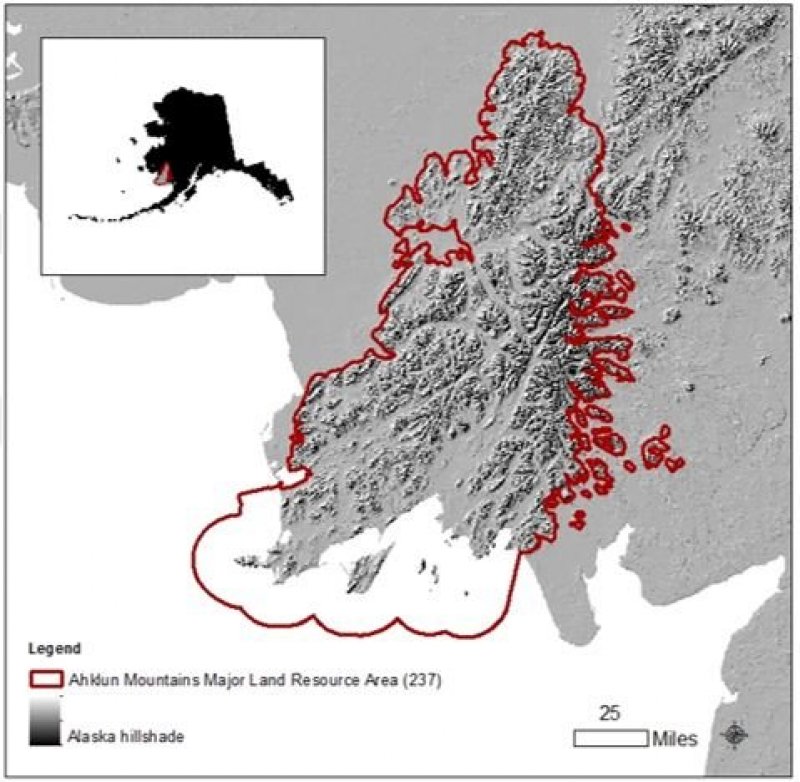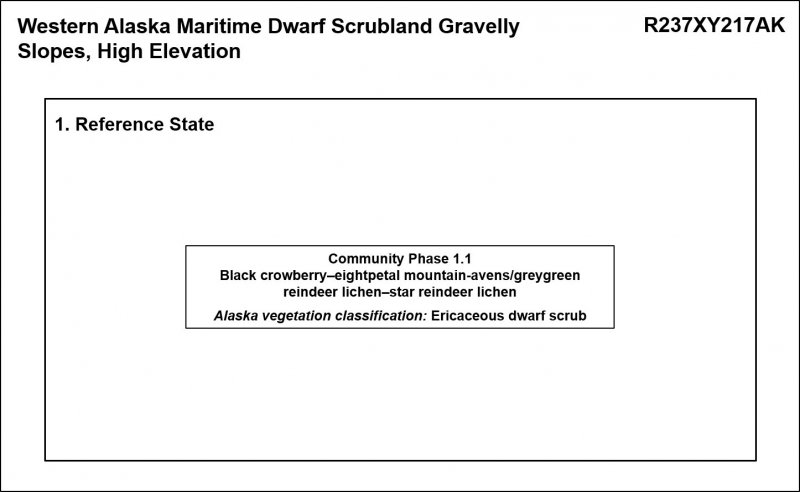

Natural Resources
Conservation Service
Ecological site R237XY217AK
Western Alaska Maritime Dwarf Scrubland Gravelly Slopes, High Elevation
Last updated: 7/23/2020
Accessed: 12/22/2025
General information
Provisional. A provisional ecological site description has undergone quality control and quality assurance review. It contains a working state and transition model and enough information to identify the ecological site.
MLRA notes
Major Land Resource Area (MLRA): 237X–Ahklun Mountains
The Ahklun Mountains Major Land Resource Area (MLRA 237) is in western Alaska (fig. 2). This MLRA covers approximately 14,555 square miles, and it includes the mountains, hills, and valleys of the Kilbuck Mountains in the north and the Ahklun Mountains in the south. Except for the Kilbuck Mountains and the highest ridges of the Ahklun Mountains, the MLRA was extensively glaciated during the Pleistocene (Kautz et al., 2004). Today, a few small glaciers persist in mountainous cirques (Gallant et al., 1995). The present-day landscape and landforms reflect this glacial history; glacial moraines and glacial drift cover much of the area (USDA-NRCS, 2006). The landscape of the MLRA is primarily defined by low, steep, rugged mountains cut by narrow-to-broad valleys. Flood plains and terraces of varying sizes are common at the lower elevations in the valley bottoms. Glacially carved valleys host many lakes. Togiak Lake is one of the largest lakes in the region. It is 13 miles long and about 9,500 acres in size. Major rivers include the Goodnews, Togiak, Kanektok, Osviak, Eek, and Arolik Rivers. Where the Goodnews and Togiak Rivers reach the coast, the nearly level to rolling deltas support numerous small lakes.
This MLRA has two distinct climatic zones: subarctic continental and maritime continental (fig. 3). The high-elevation areas are in the subarctic continental zone. The mean annual precipitation is more than 75 inches, and the mean annual air temperature is below about 27 degrees F (-3 degrees C) in extreme locations. The warmer, drier areas at the lower elevations are in the maritime continental zone. The mean annual precipitation is 20 to 50 inches, and the mean annual air temperature is about 30 to 32 degrees F (-0.2 to 1.2 degrees C) (PRISM). This climatic zone is influenced by both maritime and continental factors. The temperatures in summer are moderated by the open waters of the Bering Sea, and the temperatures in winter are more continental due to the presence of ice in the sea (Western Regional Climate Center, 2017). The seasonal ice reaches its southernmost extent off the coast of Alaska in Bristol Bay (Alaska Climate Research Center, 2017). The western coast of Alaska is also influenced by high winds from strong storms and airmasses in the Interior Region of Alaska (Hartmann, 2002).
The Ahklun Mountains MLRA is principally undeveloped wilderness. Federally managed lands include the Togiak and Alaska Maritime National Wildlife Refuges. The MLRA is sparsely populated, but it has several communities, including Togiak, Manokotak, Twin Hills, and Goodnews Bay. Togiak is the largest village. It has a population of approximately 855, most of which are Yup’ik Alaska Natives (U.S. Census Bureau, 2016). Major land uses include subsistence activities (fishing, hunting, and gathering) and wildlife recreation (USDA-NRCS, 2006; Kautz et al., 2004).
Ecological site concept
Ecological site R237XY217AK is associated with lithic soils on summits and shoulders of alpine mountains and hills. Climate, landform, elevation, and soil characteristics create a unique ecological site. No disturbance surpasses the resilience threshold required to create an early community sere. No alternate states are associated with this ecological site.
The reference plant community is an ericaceous dwarf scrubland tundra (Viereck et al., 1992) that consists dominantly of alpine shrub species. Species include eightpetal mountain-avens (Dryas octopetala), pincushion plant (Diapensia lapponica), black crowberry (Empetrum nigrum), marsh Labrador tea (Ledum palustre ssp. decumbens), and arctic willow (Salix arctica). Lichens are prevalent, including reindeer lichens (Cladina spp.), cup lichens (Cladonia spp.), snow lichens (Stereocaulon spp.), and cetraria lichens (Cetraria spp.).
Associated sites
| R237XY204AK |
Western Alaska Maritime Scrubland Loamy Slopes |
|---|---|
| R237XY205AK |
Western Alaska Maritime Scrubland Loamy Swales |
| R237XY206AK |
Western Alaska Maritime Dwarf Scrubland Loamy Drainage, High Elevation |
| R237XY202AK |
Western Alaska Maritime Mosaic Gravelly Slopes Ecological site R237XY217AK is on summits and shoulders of upland mountains and hills. Several ecological sites are directly adjacent to or in close proximity of this site. These sites typically are differentiated by one or more criteria, including landform, landform position, associated soils, associated disturbance regimes, and the type and amount of plants. The most common associated ecological sites are on mid to upper mountain slopes. These include sites R237XY202AK, R237XY204AK, R237XY205AK, and R237XY206AK. Ecotonal plant communities that have characteristics from more than one ecological site are in areas where these sites abut. |
Similar sites
| R237XY219AK |
Western Alaska Maritime Dwarf Scrubland Gravelly Slopes, Very Steep Several ecological sites in the Ahklun Mountains area support a reference plant community that consists of dwarf shrubs and is similar to that of site R237XY217AK. However, site R237XY217AK supports many alpine shrubs and forbs that are not in any other ecological site in the area. Site R237XY219AK is on steep backslopes that support different reference community plants and are subject to erosion. |
|---|

Figure 1. These landforms support a dwarf scrub community that consists dominantly of alpine species. Lichens are interspersed throughout.
Table 1. Dominant plant species
| Tree |
Not specified |
|---|---|
| Shrub |
(1) Empetrum nigrum |
| Herbaceous |
(1) Cladina rangiferina |
Click on box and path labels to scroll to the respective text.




